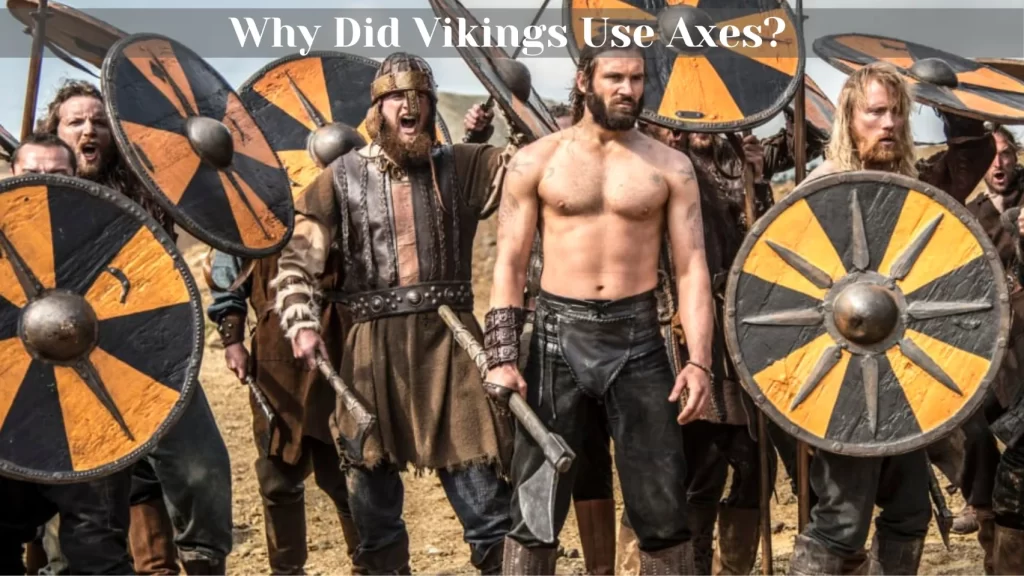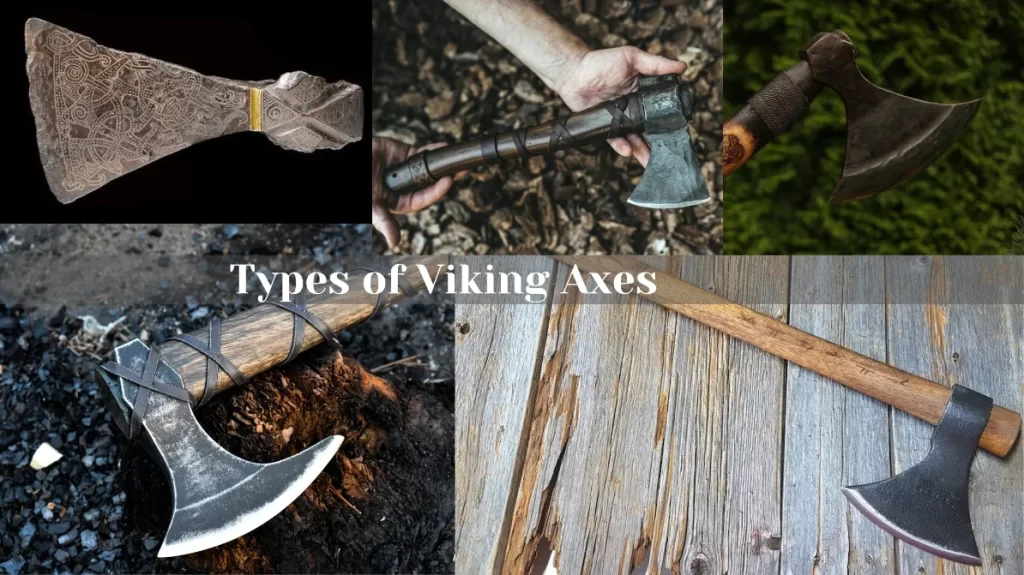You might think that the Viking axes were primarily used for fighting and raiding only, but the truth is much more complex and fascinating. Viking axes were more than just weapons, they were one of the most important and versatile tools in the Viking culture and everyday tasks.
Viking axes were used for a variety of purposes, including warfare, woodworking, shipbuilding, building houses, farming, hunting, fishing, rituals, trade, and more. They were also status symbols, the more elaborated and well-crafted an axe was, the higher the owner’s social status.
In this article, we will explore what were Viking axes used for, and how they influenced other cultures and regions.

Contents
Uses of Viking Axes
Let’s go back in the Norse history to find out what were the uses of axes in Vikings community.
Viking Axes as Tools
Viking axes were essential tools for survival and prosperity. Let’s take a look at how the Norse Vikings used their axes for different purposes.
Woodworking
Wood was one of the most important materials for the Vikings. They used wood to make furniture, houses, weapons, ships, and more. To cut logs into planks, and to chop and shape wood, they used woodworking axes, which had broad blades, long handles, and short beard.
These axes were designed to cut through wood efficiently and precisely. The Vikings also used hand axes to carve runes, which were symbols that represented sounds and meanings. Runes were used for writing, magic, and art.
Shipbuilding
The legendary Viking longships, with their iconic dragon heads, were an integral part of Viking culture. Vikings used their ships to travel, trade, raid, and explore. To build their ships, they used shipbuilding axes, which had narrow blades and short handles.
One of the most common types of Viking axes used for shipbuilding was the hewing axe. The hewing axe had a long, narrow blade that was perfect for shaping wood. Vikings also used felling axes, which were larger and heavier than hewing axes, to fall trees. The Vikings also used axes to make nails, rivets, and other metal parts that were used to join the planks together.
Hunting
Hunting was one of the main sources of food and fur for the Vikings. Viking hunters depended on their axes to provide food for their communities. The sharp blades of axes allowed for effective butchering and skinning, while the axes’ strength came in handy when dealing with larger, more challenging prey. The Vikings also used axes to skin and butcher the animals after killing them.
They hunted animals such as deer, boar, bear, elk, and more. One of the most common types of Viking axes used for hunting was the throwing axe. The throwing axe was smaller and lighter than other types of axes, and it was designed to be thrown at prey from a distance. Vikings also used bearded axes for hunting for closer animals.
Farming
Farming was another source of food and income for the Norsemen. They farmed crops such as barley, oats, rye, wheat, and more. To farm these crops, they used lightweight hand axes, with straight blades and short handles.
These axes were designed to clear land, plough fields, or harvest crops. The Vikings also used axes to chop firewood or make fences. Vikings also used billhooks, which were axes with a hooked blade, for harvesting crops.
Viking Axes as Weapons
Vikings were skilled in using axes in close combat. They would often charge into battle with their axes raised, ready to strike down their enemies. Vikings also used axes to defend themselves against enemy attacks.
The Vikings used different types of axes for different situations and preferences. Let’s take a look at the types of Viking axes used as weapons:
Why don’t we first go back in history and find out why did Vikings use axes instead of swords?
Bearded Axe
This was an axe with a long blade that extended below the handle, forming a bear or hook. This design allowed the user to grip the axe closer to the blade for more control and precision. It also allowed the user to jab or hook the enemy’s weapon or shield and pull it away. The bearded axe was one of the most popular and versatile axes among the Vikings.
Francisca (Throwing Axe)
This was a throwing axe with a short handle and a heavy, curved blade. This design made the axe easy to throw and hard to dodge. It also made the axe unpredictable and dangerous, as it could bounce or ricochet off the ground or other objects. The Francisca was mainly used by the Franks, but also adopted by some Vikings.
Dane Axe
A symbol of power and courage, the Dane axe was a large axe with a long handle and a broad blade. This design gave the axe more reach and power, allowing the user to strike multiple enemies at once or break through their defenses. The Dane axe was mainly used by the Danish Vikings, but also spread to other regions.
Hand Axe
A compact, one-handed small axe with a short handle and narrow blade was favored for its agility in combat situations. It was an easy to carry weapon in the battles that could be hidden, allowing the user to surprise or ambush the enemy. The hand axe was mainly used as a secondary weapon or a backup weapon.
Norse females were also very much into fighting and raiding, but did Vikings women use axes in battle?
Other Uses for Viking Axes
Beyond their practical applications as tools and weapons, Viking axes held a significant place in Viking society, serving as ceremonial objects, status symbols, and even currency. Let’s take a look at how the Vikings used their axes for other purposes.
Rituals and Ceremonies
Viking axes played a crucial role in various rituals and ceremonies, often associated with sacrifices, oath-taking, and burial rites. Axes were considered sacred objects, believed to possess divine power and the ability to connect the physical world with the spiritual realm.
During sacrifices, axes were used to slaughter animals as offerings to their gods, such as Odin, Thor, or Frey. They believed that these sacrifices would please their gods and grant them favor or protection.
In oath-taking ceremonies, axes were placed on ceremonial altars or held by participants as they swore their oaths, such as alliances, marriages, or contracts, signifying the binding nature of their promises and the consequences of breaking them.
In burial rites, axes were often lay to rest alongside the deceased, especially to honor their ancestors or heroes, such as kings and warriors. This act representing their status, prowess, and the tools they would need in the afterlife.
Status Symbols
Viking axes were also used to reflect the wealth, power, and social standing of their owners. Elaborately decorated axes, crafted with intricate carvings, precious metals, and gemstones, were prized possessions among the Viking elite. These ornate axes were not merely tools or weapons but rather works of art, signifying the owner’s prestige and authority.
Vikings also used their axes to mark their territory or clan, such as lands, ships, or banners. They believed that these marks would assert their authority or identity and strengthen their loyalty or unity.
Currency
Axes were also used as a means of payment in bride-prices, legal settlements, and other transactions, such as to pay fines or taxes, penalties, dues, or tributes. The exchange of axes not only facilitated trade but also reinforced social bonds and hierarchies.
Vikings also used axes to offer gifts or bribes, such as presents, donations, or rewards. They believed that these offers would create bonds or favors and foster friendship or cooperation.
Before using a Viking axe replica in the modern world, you should know the legal issues with Viking axes.
Conclusion
It won’t be wrong to say that axes were more than a weapon for Vikings. Axes were a part of Vikings culture, and they helped them shape their society in many ways. Along with serving them in battle-fields, axes were versatile companions in the daily lives of the Norse people for woodworking, building houses and ships, hunting, farming etc., they were symbols of prestige, power, and economic value, and they played a significant role in rituals, trade, and spirituality.
The legacy of Viking axes continues to this day. Viking axes are also popular collectibles and symbols of Viking culture. Viking axes are a reminder of the ingenuity, resilience, and warrior spirit of the Norse people.
Frequently Asked Questions
How did the Vikings use their axes in battle?
The Vikings used their axes in battle for combat fighting, throwing, swinging, hooking, or stabbing. They were very effecting in hacking and slashing at the enemy, and to cleave through armor and shields. They used their axes to attack the enemy from a distance or at close range, to break through their defenses or to expose their weak points, to injure them or to kill them.
Were Viking axes effective weapons?
Yes, Viking axes were very effective weapons. They were powerful and versatile, and they could be used to great effect in both close and ranged combat. Viking axes were also relatively inexpensive to produce, which made them widely available to Viking warriors.
What were the most common types of Viking axes used for battle?
The two most common types of Viking axes used for battle were the Dane axe and the bearded axe. The Dane axe was a long-handled axe with a large wide blade. The bearded axe was a shorter-handled axe with a curved blade shaped like a “beard”.
Did Viking axes have any spiritual or religious significance?
Yes, Viking axes were used in rituals and ceremonies, offering sacrifices to appease the gods. They were also seen as channels between the earthly and spiritual realms and played a role in funerary customs to guide the deceased to the afterlife.



